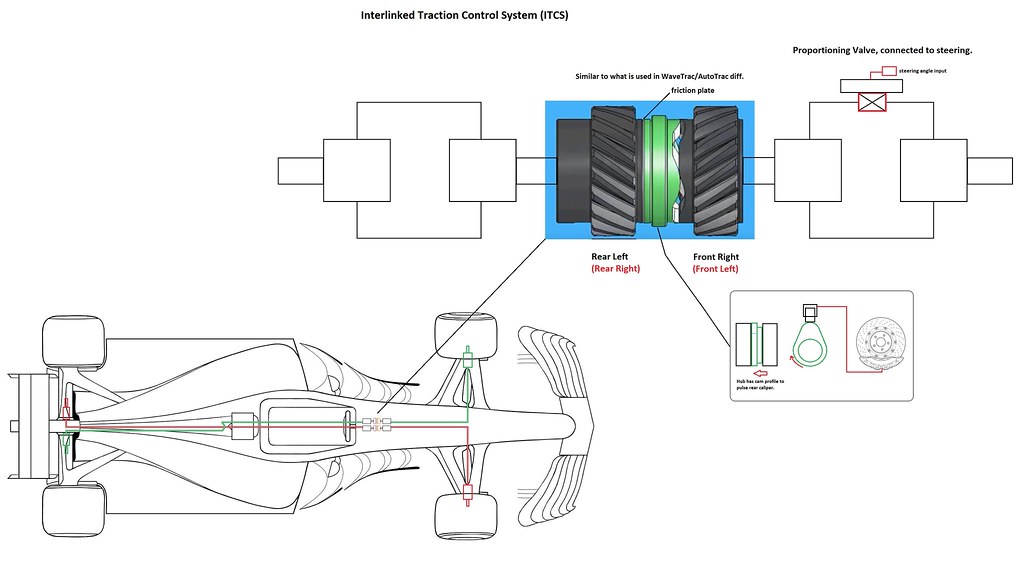So pretty much every form of traction control is banned because it's not easy to do it without electronics, the difficult part is finding the ground speed, you could use air instruments, but one way would be to reference ground speed from the front tires. I'm guessing this is how the original concept came about. By interlinking them through passive hydraulics, unless you have some way of using expensive servo valves, so a quick sketch the system would look like this:

The system using available mechanical diff's, such as WaveTrac/AutoTrac, but instead of using it in the rear, hydraulic devices rotate the wave hub based on the front and rear wheel rpm, most times the speeds match if going in a straight line, during a turn, the proportional valve, adjusts the speed of the front hydraulic device so it's proportional to steering angle and matches rear wheel rpm, an example of rear wheel rpm during a 10 degree steering angle:

So if your wheel rpm is 1200rpm, the inside is around 1080rpm and outside is around 1320rpm and the average is 1200rpm.
During acceleration and rear wheel slip, usually the inside wheel, the wave hub (connected to the front wheel, references ground speed) moves out and attempts to slow down the rear tire to match the ground speed, the hub has a cam profile, which pumps that rear caliper at a certain frequency, there are other ways to slow the wheel but I chose braking. I connected front right/rear left since that front is most loaded. But it can be interlinked differently. Overall, the driver can apply a lot more torque to the outside wheel and not worry about the inside breaking traction.
But the problem with this system, it's basically 4 wheel drive. The driver can just leave it on, since it couples the front and rear through hydraulic elements using a friction hub like the Wavetrac.
There are a few ways to decouple, one would be the following sketch:

The system uses a balance bar and the linear motion of the cylinder at varying speeds. During a turn the cylinder would move to match the rear cylinder speed, which also has a cylinder, if the rear loses traction, the cylinder moves up, contacting the valve which pulses the caliper on that wheel. You can do front brake locking (ABS) with additional valves. So during front brake lock, left or right, the front cylinder moves down and doesn't match the speed of the rear cylinder and pushes the valve to release the pressure in that brake line. For rear brake lock, it's the opposite.
The rules on traction control and torque transfer are pretty clear, but wheel speed is not mentioned, if you can slow down the inside wheel and speed up the outside wheel, then traction control is just a result from change in the wheel speed, a quick sketch:

This is a dual axis differential which has two pinions, which regulates speed of each rear tire based on steering angle. Connected to the output shaft of the transmission, I put an inner and outer shaft just so the image won't look so messy. Everything else is pretty much the same, as the rear wheel starts to increase rpm relative to the front which references ground speed, the valve opens to allow the CVT hubs to move, the variable ratio differential slows down the faster wheel via pulsation (ie: 3.5 to 4 ratio or 3.5 to 3 ratio for the outside wheel). These have been around since the 90's. Not sure if any vehicle has used them.
Obviously you want it to pulsate rather than simply slow the wheel down. So now the driver can rotate the car easier, kind of like 4 wheel steering, less steering input, less tire scrub, less chance of breaking an axle But the system is heavy since you need two ring and pinions.
It would take some fine tuning and the driver can adjust the amount of pulsation. And dealing with fluid temperature. The rules talk a lot about transferring torque from the slipping wheel to the other wheel but nothing about wheel rpm, since wheel rpm doesn't mean wheel slippage. And the rules don't differentiate a transmissions from a differential, I guess they consider it as one, a CVT differential is not mentioned. But who knows.
